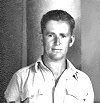What was the role of the 2/KRRC Motor Battalion?
Len Moore fought with the 2nd Battalion Kings Royal Rifle Corps 2/KRRC across the deserts of North Africa during WW2 from 1941 to 1943. They were equipped with two different soft skinned vehicles and later the M3 Armoured Personel Carrier for transporting troops, equipment, food rations and ammunition.

Len Moore 2nd Battalion Kings Royal Rifle Corps
The 2nd KRRC Motor Battalion's role was to be mobile, flexible and sufficiently armed enough to carry out rapidly all the infantry tasks needed to keep our tanks on the move and to deny mobility to the enemy. By day, tanks particularly needed help when encountering enemy in villages or woods or covering river crossings, defiles or minefield gaps.
By night, it protected tanks in leaguer and carried out patrols. In defence it could screen a wide front by aggressive patrolling, or, once effective anti-tank guns had been received, form strong points on which our tanks could withdraw if pressed. The lack of an effective anti-tank gun halved Motor Battalion effectiveness from 1941 to June 1942.
The Motor Company
There were four of these, until, in summer 1942, a Support Company was formed, using the long awaited 6 pounder anti-tank gun. The Motor Company had all the elements needed for independent action, whether in the desert with an RHA Battery of 25 pounder guns, alone capable of deterring German tanks, or under command of an Armoured Regiment.
Reconnaissance
It had a Scout Platoon of 2 HQ carriers and 3 Sections each of 3 carriers, each carrier having at least one LMG. These, with their low profile, could reconnoitre at speed, watch a flank or, using light armour and mobility, carry Bren crews to a vantage point through enemy fire.
Assault
The 3 Motor Platoons, each with a Platoon HQ and 3 Sections mounted in 15cwt (l ton) vehicles, were driven by Riflemen. Until 1943, after the desert, these were 4x2 unarmoured trucks. In 1943, Battalions in the Mediterranean received armoured white scout cars and in the UK International half-tracks, all from the USA.
A particular feature of Motor Platoon work throughout world war 11 was expertise in patrolling, above all at night. Every Platoon could lift or lay mines, use explosives and direct the fire Fire support.
Mortars
Besides the 2 inch mortar in each Motor Platoon and Scout Section, particularly useful for smoke screens, the Motor Company had a Section of two 2 inch mortars. They were most useful in laying down defensive fire and, latterly carried in 2 carriers, often worked with the Scout Platoon.

The solders from the Rhodesian Rifles using a 2-inch mortar in the North African Desert
Handheld Anti-tank weapons
The Boys .55 inch Anti-Tank Rifle was ineffective against German armour after 1940. German tanks rarely came in range of the PIAT which replaced it. The Motor Company was designed to be protected from enemy tanks by always working with our armour. If left unsupported in open country, as at Sidi Rezegh, it would be overrun, however staunchly it fought.
Command and Control
The Motor Company Commander had short range radio communications on the move with his Scout Platoon and to Battalion HQ with his 21C in his Command vehicle. Communications with his Motor Platoons on the move or dismounted were a problem throughout World War Il because of the inadequate range of sets. Control when mounted was largely exercised by flag signals, and by whistle and hand signal when on foot.
Logistics
Each Motor Company truck or carrier carried reserve ammunition, petrol, rations and water; normally sufficient for a day's operations. The CJS M carried a further reserve of ammunition at Company HQ, and there was also a stretcher bearer vehicle. The crew of each vehicle cooked for themselves, so could easily be detached. The Colour Sergeant controlled an A Echelon, consisting of his own 3 ton vehicle with rations, cooks and stores, one carrying petrol and the fitters, one with ammunition and a I ton water vehicle. He replenished the Company each night, wherever it was leaguered and then went back to refill from Battalion B Echelon.